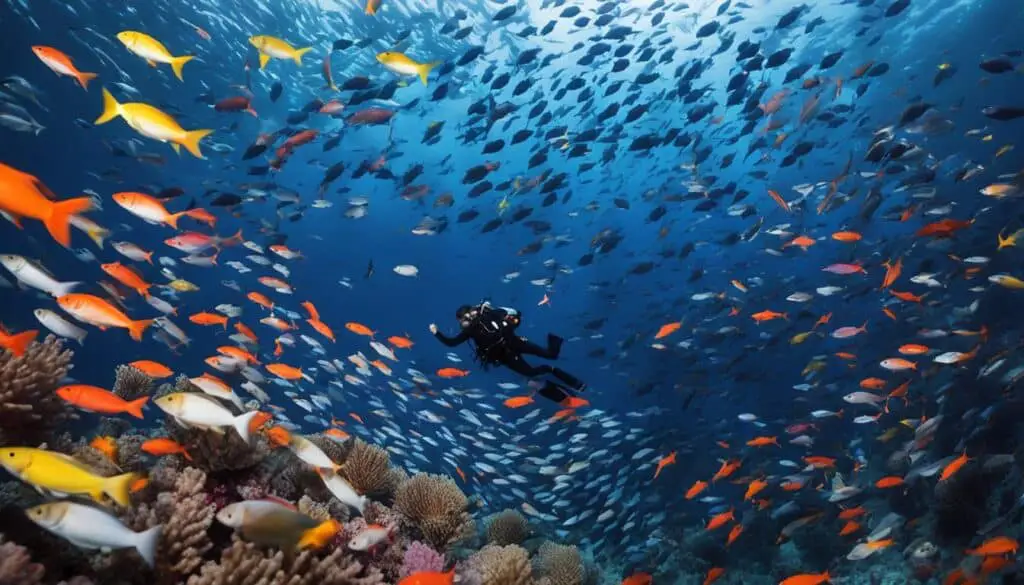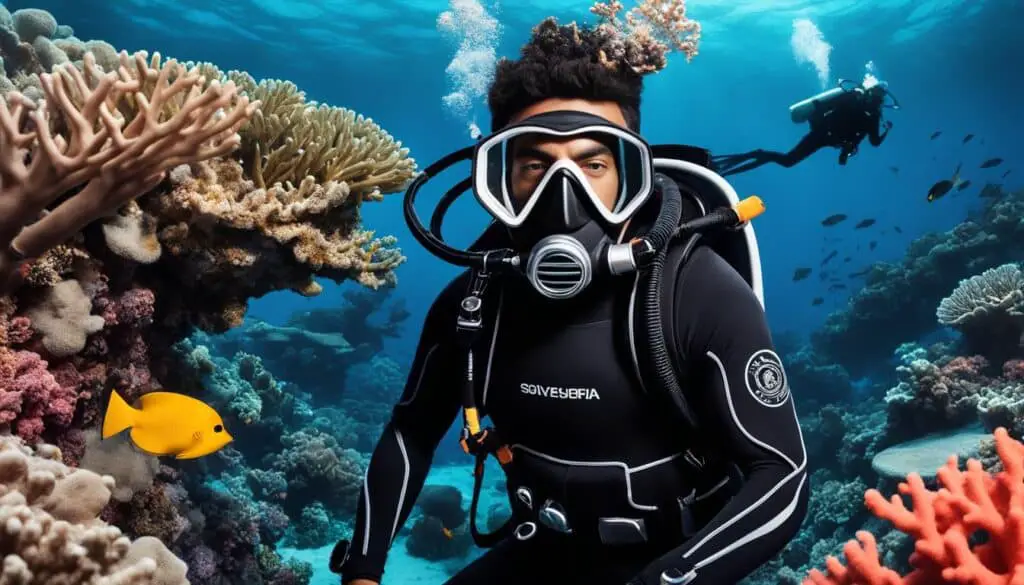The world of diving equipment is constantly evolving with new innovations and trends that enhance the underwater experience. From advanced technology to improved safety features, divers now have access to cutting-edge gear that allows them to explore the depths with confidence and ease. Let’s take a closer look at the latest innovations and trends shaping the world of diving equipment.
Key Takeaways:
- Advances in dive computer technology are revolutionizing the way divers plan and execute their dives, with features like wireless connectivity and customizable dive profiles.
- Manufacturers are focusing on developing lightweight and compact gear designs, improving mobility and comfort during dives.
- There is a growing demand for eco-friendly dive equipment, with manufacturers incorporating sustainable materials and practices to minimize the environmental impact of diving.
- The constantly evolving world of diving equipment promises even more exciting developments in the future, enhancing safety, comfort, and enjoyment for divers.
Advances in Dive Computer Technology
Dive computers have revolutionized the way divers explore the underwater world. These sophisticated devices are no longer just simple depth and time trackers – they have evolved into powerful tools that provide divers with essential information for a safer and more enjoyable diving experience.
Recent advancements in dive computer technology have introduced a range of new features that have taken diving to the next level. These innovations not only enhance safety but also provide divers with real-time data and insights, allowing them to make more informed decisions while underwater.
Wireless Connectivity for Seamless Data Transfer
One of the latest advancements in dive computer technology is wireless connectivity. Divers can now connect their dive computers to other devices, such as smartphones or dive log apps, through Bluetooth or Wi-Fi. This enables the automatic transfer of dive data, eliminating the need for manual entry and streamlining the post-dive analysis process.
Advanced Algorithms for Precise Dive Planning
Dive computers now come equipped with advanced algorithms that calculate important dive parameters in real time. These algorithms take into account factors such as depth, time, gas mixtures, and individual physiological data to provide accurate and personalized dive profiles. This ensures that divers stay within safe decompression limits and helps minimize the risk of decompression sickness.
Customizable Dive Profiles for Personalized Experiences
Gone are the days of standardized dive profiles. Modern dive computers offer customizable dive profiles, allowing divers to tailor their dives to their specific preferences and skill levels. Divers can set parameters such as ascent rates, safety stops, and conservative or aggressive decompression calculations, giving them more control over their underwater adventures.
Integrated GPS Systems for Enhanced Navigation
Some dive computers now feature integrated GPS systems, allowing divers to track their position and navigate underwater with greater accuracy. These systems provide real-time location data, making it easier to find specific dive sites, underwater landmarks, or even locate the dive boat after surfacing. They offer an added layer of safety and convenience for divers exploring unfamiliar or challenging dive environments.
Smartphone Apps for Dive Data Management
With the rise of smartphone technology, dive computers have also embraced the digital world. Many dive computer manufacturers now offer companion apps that allow divers to sync their dive data to their smartphones. These apps provide a centralized platform for storing and analyzing dive logs, keeping track of certifications, and even connecting with dive buddies. Additionally, some apps offer social features that allow divers to share their dive experiences with the diving community.
As dive computer technology continues to advance, divers can look forward to even more exciting features and capabilities. Whether it’s enhancing safety, personalizing dive profiles, or improving data management, these advancements will undoubtedly contribute to a more immersive and enjoyable underwater experience.
Lightweight and Compact Gear Designs
Traditional diving gear can be bulky and heavy, restricting divers’ mobility and affecting their overall comfort underwater. To address this, manufacturers are now focusing on developing lightweight and compact gear designs. This includes lightweight BCDs (buoyancy control devices), streamlined regulators, and compact dive masks that offer a wide field of vision. These advancements not only make it easier for divers to maneuver underwater but also reduce fatigue and improve overall enjoyment during dives.

The use of lightweight materials, such as carbon fiber, in the construction of diving gear has significantly reduced the weight without compromising on durability and strength. These materials are not only lightweight but also resistant to corrosion, ensuring that the equipment can withstand the harsh conditions of the ocean.
Another aspect of lightweight and compact gear designs is the integration of multiple functionalities into a single piece of equipment. For example, some dive masks now come with an integrated snorkel, eliminating the need for a separate snorkel device. This not only reduces the amount of gear divers need to carry but also enhances convenience and streamlines the diving experience.
“The advancements in lightweight and compact gear designs have revolutionized the diving industry. It’s now possible for divers to explore the depths with ease and comfort, without having to compromise on safety or performance.” – Sarah Johnson, Experienced Diver
Furthermore, lightweight and compact gear designs also have a positive impact on travel and storage. Divers no longer need to worry about excessive baggage or bulky equipment taking up valuable space. Compact designs allow for easy packing, making diving accessible and hassle-free for those who love to explore different dive sites around the world.
Overall, the development of lightweight and compact gear designs has transformed the diving experience, providing divers with equipment that prioritizes mobility, comfort, and convenience. As technology continues to advance, we can expect further innovations in lightweight diving equipment that will continue to enhance the underwater exploration.
| Advantages of Lightweight and Compact Gear Designs | Disadvantages of Traditional Bulkier Gear |
|---|---|
| Enhanced mobility and maneuverability underwater | Restricted movement and limited agility |
| Reduced fatigue during dives | Increased fatigue due to carrying heavy equipment |
| Easier packing and travel convenience | Additional baggage and storage concerns |
| Improved comfort and overall enjoyment | Decreased comfort and potential discomfort |
Environmentally Friendly Dive Equipment
As awareness of environmental conservation grows, there is an increasing demand for eco-friendly diving gear that minimizes the impact on our underwater ecosystems. Manufacturers have taken note of this demand and are now incorporating sustainable materials and production processes into their dive equipment, promoting a greener approach to diving.
Reducing Environmental Impact
One of the key ways manufacturers are addressing the environmental impact of diving is by using recycled or biodegradable materials in the production of dive gear. This includes materials such as recycled plastics for fins and dive masks, as well as biodegradable neoprene alternatives for wet suits.
In addition to the materials used, manufacturers are also conscious of minimizing packaging waste. They are adopting eco-friendly packaging solutions, such as recyclable cardboard or reusable fabric bags, instead of single-use plastic packaging.
Sustainable Manufacturing Practices
Manufacturers are not only focusing on the materials used but also on implementing sustainable manufacturing practices. This includes ensuring that manufacturing processes are energy-efficient and minimize water usage. By adopting sustainable practices, manufacturers aim to reduce the carbon footprint associated with the production of dive equipment.
Protecting Marine Ecosystems
Some companies have gone a step further in their commitment to environmental conservation by creating gear that has a minimal impact on marine ecosystems. For example, reef-safe sunscreens are becoming increasingly popular among divers as they are designed to be biodegradable and free from harmful chemicals that can harm coral reefs. In addition, non-toxic diving weights are being developed as an alternative to traditional lead weights, which can be detrimental to marine life.

By choosing eco-friendly diving gear and adopting sustainable practices, divers can enjoy their underwater adventures while minimizing their impact on the environment. The industry’s focus on sustainability reflects a growing awareness and commitment to preserving the beauty and health of our oceans for future generations of divers to explore and appreciate.
Conclusion
The world of diving equipment continues to evolve with new innovations and trends that enhance the diving experience. From advances in dive computer technology to lightweight and compact gear designs, divers now have access to gear that improves safety, comfort, and overall enjoyment.
One of the notable developments in the diving equipment industry is the focus on eco-friendly dive gear. Manufacturers are actively incorporating sustainable materials and production processes into their products, reflecting a growing commitment to preserving the underwater environment.
Looking ahead, as technology continues to advance, we can expect even more exciting developments in the world of diving equipment. Diving enthusiasts can anticipate further enhancements that will enable them to explore the depths below with greater ease and excitement.
FAQ
What are some diving equipment innovations?
Some of the latest innovations in diving equipment include advanced dive computers with features like wireless connectivity and integrated GPS systems, lightweight and compact gear designs for improved mobility, and eco-friendly gear made from sustainable materials.
What are the benefits of using a dive computer?
Dive computers provide divers with crucial information such as depth, time, decompression limits, and more. They also offer advanced features like customizable dive profiles and the ability to track and share dive data through smartphone apps, enhancing safety and providing real-time insights.
How do lightweight and compact gear designs improve the diving experience?
Lightweight and compact gear designs, such as lightweight BCDs, streamlined regulators, and compact dive masks, improve divers’ mobility and comfort underwater. These advancements make it easier to maneuver and reduce fatigue, leading to a more enjoyable diving experience.
What is eco-friendly dive equipment?
Eco-friendly dive equipment refers to gear that is made from sustainable materials and produced using environmentally friendly practices. This includes using recycled or biodegradable materials, minimizing packaging waste, and creating gear that has minimal impact on marine ecosystems.
What are the benefits of using eco-friendly dive equipment?
By using eco-friendly dive equipment, divers can minimize their environmental impact while enjoying their underwater adventures. Sustainable gear helps reduce waste and supports the preservation of marine ecosystems, contributing to long-term environmental conservation efforts.
